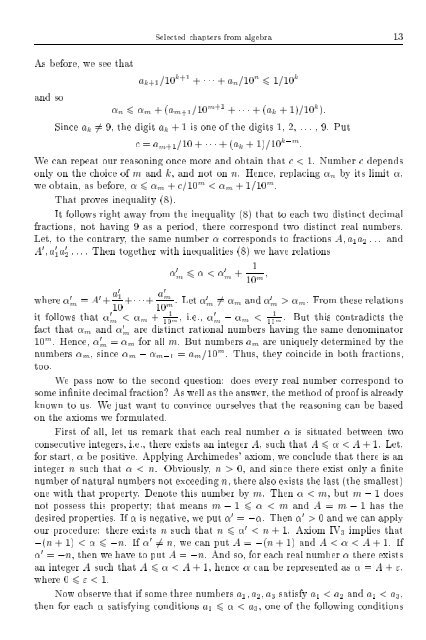12 I. R. <strong>Shafarevich</strong>THEOREM 2. Two distinct innite decimal fractions, neither of which has 9asaperiod, are corresponded to distinct real numbers.The proof can be obtained easily if we connect our construction of a realnumber, dened by a decimal fraction, with the usual measuring of numbers withaccuracy of 1=10 m , with deciency and excess. One has to divide the line intosegments of the length 1=10 m , whose endpoints are rational numbers with denominator10 m . Then each point from the line, that is, each real number, falls in oneof the segments. The endpoints of the segment give a measure of the number, withdeciency and excess and accuracy of 1=10 m . However, violating of one-to-one correspondenceappears because of the endpoints of segments themselves. To whichofthe segments, left or right, is each ofthesepoints corresponded? This is the sameproblem which appears in connection with number 9in the period. We are goingto show that our choice (without 9in periods) corresponds to the case when theendpoints of segments are always attached to segments on the right-hand side. Inother words, the constructed numbers m and the number which they dene areconnected by the relation(8) m 6 < m + 110 m :(The fact that numbers m are rational with the denominators of the form 10 mfollows from their form (5).)Remember that number was dened as the limit of the sequence 1 , 2 ,... , n , ... . All numbers n with n > m, obviously satisfy the condition n > m .Hence, such an inequality is valid for their limit . Really, from the assumption< m we could deduce that n ; =( n ; m )+( m ;) > m ; for all n > m.But, by the denition of limit, the absolute value of the number n ; is smallerthan an arbitrary given positive number for n large enough. This contradicts thefact that it is not smaller than the xed positive number m ; (see Problem 2 inSection 2).In this way the left-hand inequality in (8) is proved. The right-hand one canbe proved similarly, if the sign < is replaced by 6. Namely, for each n > m wehave(9) n = m + a m+110 m+1 + + a n10 n 6 m + 110 m am+110 + + a n10 n;m and applying inequality (6) we conclude that n < m + 110 m . Repeating theprevious reasoning we obtain that 6 m + 110 m .But, if we want to obtain the right-hand inequality in (8) with the sign kwe can write n = m +(a m+1 =10 m+1 + + a k =10 k )+(a k+1 =10 k+1 + + a n =10 n ):
Selected chapters from algebra 13As before, we see thatand soa k+1 =10 k+1 + + a n =10 n 6 1=10 k n 6 m +(a m+1 =10 m+1 + +(a k +1)=10 k ):Since a k 6= 9, the digit a k + 1 is one of the digits 1, 2, . . . , 9. Putc = a m+1 =10 + +(a k +1)=10 k;m :We can repeat our reasoning once more and obtain that c m. From these relationsit follows that 0 m < m + 110 m , i.e., 0 m ; m < 110 m . But this contradicts thefact that m and 0 m are distinct rational numbers having the same denominator10 m . Hence, 0 m = m for all m. But numbers a m are uniquely determined by thenumbers m ,since m ; m;1 = a m =10 m . Thus, they coincide in both fractions,too.We pass now to the second question: does every real number correspond tosome innite decimal fraction? As well as the answer, the method of proof is alreadyknown to us. We justwant toconvince ourselves that the reasoning can be basedon the axioms we formulated.First of all, let us remark that each real number is situated between twoconsecutive integers, i.e., there exists an integer A, suchthatA 6
















